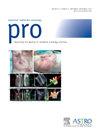Effect of Treatment Delivery Schedule for Patients With Early-Stage Non-Small Cell Lung Cancer Treated With Stereotactic Ablative Radiation Therapy: A Population-Based Analysis
IF 3.4
3区 医学
Q2 ONCOLOGY
引用次数: 0
Abstract
Purpose
The optimal SABR treatment delivery schedule in stage I non-small cell lung cancer (NSCLC) remains unclear. This population-based study investigated grade ≥2 toxicity rates, local failure (LF), and overall survival (OS) in patients treated with 48 Gy in 4 fractions scheduled every other day versus daily with weekends and consecutive daily without weekends.
Methods and Materials
Between January 2019 and June 2022, treatment records using 48 Gy in 4 fractions were extracted from a provincial cancer registry and grouped by delivery as every other day, daily with weekends, or consecutive daily without weekends. Toxicity events were recorded using National Cancer Institute Common Terminology Criteria for Adverse Events, version 5.0. The Kaplan-Meier method was used to compute OS and LF was calculated using cumulative incidence methods with death as a competing risk. Cox regression analyses and Fine-Gray modeling was used to assess for variables associated with OS and LF, respectively.
Results
Of 404 patients meeting study criteria, 190, 111, and 103 received SABR every other day, daily with weekends, and consecutive daily without weekends, respectively. More patients receiving SABR daily with weekends were medically inoperable and more patients receiving SABR consecutive daily without weekends had tumors abutting the chest wall. Median follow-up time was 29.5 months (IQR, 19.2-38.4 months). Overall toxicity was low, with crude rates of acute and late grade ≥2 toxicity not being statistically different among the groups. No grade 4 or 5 toxicities were recorded. LF rates at 24 months were not different at 7.5% (95% CI, 3.7-11.3), 9.5% (95% CI, 3.9-15.1), and 11.0% (95% CI, 4.9-17.2) for the every other day, daily with weekends, and consecutive daily without weekends groups, respectively (P = .60). Schedules of daily with weekends and consecutive daily without weekends were not associated with LF. Similarly, no significant differences in median OS were found among the every other day, daily with weekends, and consecutive daily without weekends groups at 47.5 months (95% CI, 39.26-55.74), 52.7 months (95% CI, 34.7-70.7), and 49.0 months (95% CI, 31.6-66.4), respectively. Schedules of daily with weekends and consecutive daily without weekends were not associated with OS.
Conclusions
This population-based study demonstrated no statistically significant differences in grade ≥2 toxicity rates, LF, and OS for patients with stage I NSCLC treated with lung SABR using 48 Gy in 4 fractions delivered every other day, daily with weekends, and consecutive daily without weekends. Patient convenience and optimization of resources may be considered when choosing a lung SABR treatment delivery schedule.
立体定向消融放疗对早期非小细胞肺癌患者治疗时间安排的影响:基于人群的分析。
目的:I期非小细胞肺癌(NSCLC)的最佳立体定向消融体放疗(SABR)给药计划仍不明确。这项基于人群的研究调查了隔日(QOD)与每日(含周末)、连续每日(不含周末)48 Gy 分 4 次治疗患者的≥2 级毒性率、局部失败(LF)和总生存率(OS):2019年1月至2022年6月期间,从省级癌症登记处提取了使用48 Gy分4次治疗的记录,并按QOD、QDW或QD进行分组。毒性事件使用 CTCAE v5.0 进行记录。OS 采用 Kaplan-Meier 法计算,LF 采用累积发生率法计算,死亡为竞争风险。Cox回归分析和Fine-Gray模型分别用于评估与OS和LF相关的变量:在符合研究标准的 404 名患者中,分别有 190 人、111 人和 103 人接受了 QOD、QDW 和 QD SABR。更多接受 QDW SABR 的患者无法进行手术,更多接受 QD SABR 的患者肿瘤紧贴胸壁。中位随访时间为 29.5 个月(四分位数间距 [IQR] 19.2-38.4)。总体毒性较低,急性和晚期≥2级毒性的粗比率在各组间无统计学差异。没有记录到 4 级或 5 级毒性。QOD 组、QDW 组和 QD 组 24 个月的 LF 率分别为 7.5%(95% 置信区间 [CI] 3.7-11.3)、9.5%(95% CI 3.9-15.1)和 11.0%(95% CI 4.9-17.2),无差异(p = 0.60)。QDW 和 QD 方案与 LR 无关。同样,QOD组、QDW组和QD组的中位OS分别为47.5个月(95% CI 39.26-55,74)、52.7个月(95% CI 34.7-70.7)和49.0个月(95% CI 31.6-66.4),无明显差异。QDW和QD方案与OS无关:这项以人群为基础的研究表明,I期NSCLC患者接受肺SABR治疗时,采用48 Gy分4次QOD、QDW和QD给药,在≥2级毒性率、LF和OS方面没有统计学意义上的显著差异。在选择肺部 SABR 治疗给药时间表时,可以考虑患者的便利性和资源的优化。
本文章由计算机程序翻译,如有差异,请以英文原文为准。
求助全文
约1分钟内获得全文
求助全文
来源期刊

Practical Radiation Oncology
Medicine-Radiology, Nuclear Medicine and Imaging
CiteScore
5.20
自引率
6.10%
发文量
177
审稿时长
34 days
期刊介绍:
The overarching mission of Practical Radiation Oncology is to improve the quality of radiation oncology practice. PRO''s purpose is to document the state of current practice, providing background for those in training and continuing education for practitioners, through discussion and illustration of new techniques, evaluation of current practices, and publication of case reports. PRO strives to provide its readers content that emphasizes knowledge "with a purpose." The content of PRO includes:
Original articles focusing on patient safety, quality measurement, or quality improvement initiatives
Original articles focusing on imaging, contouring, target delineation, simulation, treatment planning, immobilization, organ motion, and other practical issues
ASTRO guidelines, position papers, and consensus statements
Essays that highlight enriching personal experiences in caring for cancer patients and their families.
 求助内容:
求助内容: 应助结果提醒方式:
应助结果提醒方式:


